|
Air Flow
Measurements |
| Dwyer $25 Vane
Air Velocity Meter
http://www.dwyer-inst.com/
then search for "Vaneometer"
|
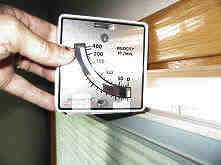 This
very simple and inexpensive Dwyer gage measures air velocities in the range
from 10 fpm up to 400 fpm. The incoming air stream deflects a vane up
the meter scale. It has just about the right amount of damping to give
steady readings, but still react to changes. I use this meter and like
it a lot. Note that the upper limit of 400fpm is to low for typical
flow in fan forced system. It is ideal for the flow velocities
encountered in thermosyphon or natural convection systems. About
the only negative is that it can only measure horizontal flow, but you can
change the flow direction with something like a gutter pipe elbow so
it is horizontal, and measure this. Only $25. This
very simple and inexpensive Dwyer gage measures air velocities in the range
from 10 fpm up to 400 fpm. The incoming air stream deflects a vane up
the meter scale. It has just about the right amount of damping to give
steady readings, but still react to changes. I use this meter and like
it a lot. Note that the upper limit of 400fpm is to low for typical
flow in fan forced system. It is ideal for the flow velocities
encountered in thermosyphon or natural convection systems. About
the only negative is that it can only measure horizontal flow, but you can
change the flow direction with something like a gutter pipe elbow so
it is horizontal, and measure this. Only $25. |
| Micro Turbine
Wind Meters
www.nkhome.com/ww/wwindex.html
Other suppliers make similar meters -- a search under "Wind Meters" will
turn some up.
|
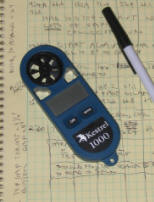 These
wind meters use a small turbine whose rotation rate is measured to determine
air velocity. This Kestrel works well from about 70 fpm up to
several thousand fpm. These
wind meters use a small turbine whose rotation rate is measured to determine
air velocity. This Kestrel works well from about 70 fpm up to
several thousand fpm.I have used the one in the picture for several years and think
it works quite well. There are several brands and many models. This model is
about $80. They also come in models that include other sensors for
temperature, humidity, altitude, ... I think that some now even offer
some form of logging. |
| Garbage Bag
Airflow Measurements Evaluation of Flow Capture Techniques for Measuring
HVAC Grille Airflow
Or, how to use garbage bags and laundry baskets to measure
airflow
Lawrence Berkeley National Laboratory
Full How-To Report (pdf)
More
on Same (pdf) |
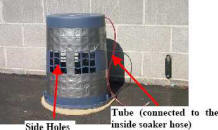 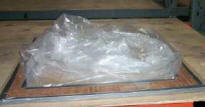
This is a great and practical piece on how to measure airflows accurately
using timed filling of garbage bags, or simple pressure difference across a
flow resistance, where the pressure difference is generated with a simple
laundry basket. |
|
Adventures in Measuring Airflow for a Solar Collector... |
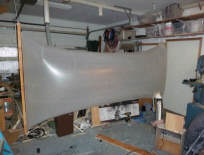 Some
notes on various ways to measure airflow for a solar collector, and how well
they work (or don't). Some
notes on various ways to measure airflow for a solar collector, and how well
they work (or don't). |
|
Temperature
Measurements |
| Ordinary
Thermometers |
 Ordinary
hardware store alcohol thermometers work fine for measuring temperatures in
most solar thermal systems. Ordinary
hardware store alcohol thermometers work fine for measuring temperatures in
most solar thermal systems.When you buy the thermometers, try to select ones from the bin that read the same
temperature. In most cases, you will be interested in the difference
between the readings on two thermometers, so the absolute accuracy is not
usually critical, but having thermometers that are all off by the same
amount helps.
When you place them, try to get the bulb into the air stream you are
measuring, and keep them out of direct sun (this may require a shade of some
type).
For most projects, you will get better results if you take and record
several readings over a time span. If more accurate measurements
are needed, the thermometers can be calibrated as described below. Every
once in a while, bring them all together and see if they read the same
temperature -- throw away any that don't. Here is what happens when
plastic thermometers get a bit
too warm :) |
|
Better thermometers
|
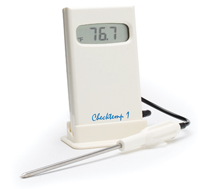 If you want to move up to a more accurate and precise thermometer, here is one example. If you want to move up to a more accurate and precise thermometer, here is one example.
This is the Hanna Checktemp. It is thermistor based with a stainless proble that can be inserted in air or liquid. It maintains an accuracy of +- 0.5F over its -58F to +302F range. It comes with a calibration certificate and it has a built in calibration test you can run any time.
About $25.
|
| Thermistors
|
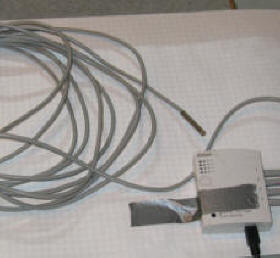 Thermistors are semiconducting
devices whose resistance varies as a function of temperature. This
resistance change is used to measure temperature. They are
relatively cheap, can be quite accurate (e.g. 1/4F over the solar thermal
range), and are fairly rugged when packaged well. Thermistors are semiconducting
devices whose resistance varies as a function of temperature. This
resistance change is used to measure temperature. They are
relatively cheap, can be quite accurate (e.g. 1/4F over the solar thermal
range), and are fairly rugged when packaged well.Picture of logger with
thermistor above, and
thermistor packaged in stainless can.
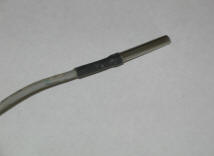 They require some circuitry and a display to show the temperature, or a
data logger to record the temperature readings. Or, an ohm meter can
be used to find the resistance, and then look up the temperature in a table. They require some circuitry and a display to show the temperature, or a
data logger to record the temperature readings. Or, an ohm meter can
be used to find the resistance, and then look up the temperature in a table.
If you decide to invest in a data logger, the loggers that use thermistor sensors
tend to be among the most affordable. The picture shows a thermistor sensor
enclosed in a stainless steel can, and connected to a cable that is plugged
into a data logger. |
| Thermocouples
|
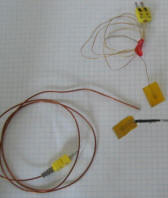 A thermocouple is a junction of two
different metals. Temperature changes at the junction generate a
voltage that is proportional to the temperature. A thermocouple is a junction of two
different metals. Temperature changes at the junction generate a
voltage that is proportional to the temperature.
More... |
| IR Thermometers |
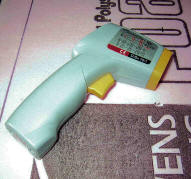
IR thermometers measure surface temperature by measuring the IR radiation emitted
from the surface. About $50.
You can use them for measuring surface
temperatures in solar thermal experiments, and also to see if your tires are
overheating, or your beef stew is up to temperature -- no household should be
without one.
They are often the easiest way to measure surface temperatures.
Some caution must be used, in that they assume that the IR emissivity of the
the surface is 0.95. Many surfaces are close to this, but some
surfaces (e.g. polished metals) are much less. In some cases this
ambiguity can be removed by putting a piece of dark colored tape on the
surface, and doing the measurement on the tape. You can get air
temperature by waving a sheet of paper around in the air, and then measuring
the paper surface temperature with the IR thermometer. I have a little
matchbook size one that I carry around some of the time -- they are great
for getting a better understanding of the thermal physics of the world
around us. The matchbook size model costs $25.. |
|
Thermal Imaging Cameras |
 Thermal
imaging cameras offer an unmatched capability to view the temperatures over
a whole surface. Thermal
imaging cameras offer an unmatched capability to view the temperatures over
a whole surface.
They have been almost prohibitively expense, but over the last few years
have come down a lot as some entry level lines have been introduced with
lower prices that have been steadily dropping. The lowest priced ones
are now a bit over $1000 -- still a lot, but much better than $10,000.
I recently took the plunge and got a FLIR IR camera.
My impressions of the
FLIR so far are here... |
|
An Arduino based homemade thermal imager for cheap... |
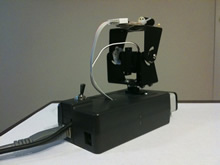 This is an IR (thermal) camera that you can build for a couple hundred(?) dollars. This is an IR (thermal) camera that you can build for a couple hundred(?) dollars.
Instead of the array of sensors that most thermal imagers use, it uses a single IR sensor that is scanned over the target object, then an image is put together from the set of readings taken during the scan.
The upside is the price and the downside is the time it takes to scan an image (about 6 minutes?). Pretty clever.
|
|
Water Flow
Measurements |
| Timed Filling of
A Bucket Gary |
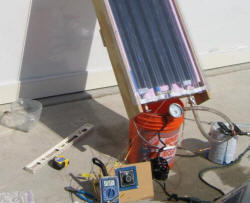 If you can arrange it so that the
fluid flow to be measured can be diverted to a container of know size you can get very
accurate flow rate measurements by just timing how long it takes to fill the
container. A stopwatch is helpful for accurate
measurements. Make sure that whatever you do to divert the
flow does not itself change the flow rate. If you do this carefully, it will provide better accuracy than
all but the most sophisticated flow meters, and do it for zero cost. If you can arrange it so that the
fluid flow to be measured can be diverted to a container of know size you can get very
accurate flow rate measurements by just timing how long it takes to fill the
container. A stopwatch is helpful for accurate
measurements. Make sure that whatever you do to divert the
flow does not itself change the flow rate. If you do this carefully, it will provide better accuracy than
all but the most sophisticated flow meters, and do it for zero cost.In
the picture, there is a submersible pump in the bucket that pumps water
around the collector, and back into the bucket via the line with the flow
control clamp on it. To measure flow, the line going back into the
bucket is redirected to the 2 qt measuring bowl in the background, and the
fill time measured. |
|
Using the DLJ Water Meter for Flow Measurement |
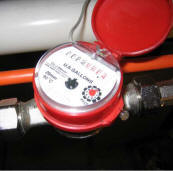 An
example of using these water meters to measure and log flow rate and total
flow of water (including hot water). An
example of using these water meters to measure and log flow rate and total
flow of water (including hot water).More ... |
|
$5 DIY Flow Meter Gary
|
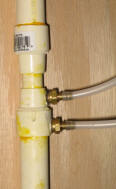 A
simple flow meter made from a couple of standard CPVC 3/4 by 1/2 reducers
installed back-to-back. A
simple flow meter made from a couple of standard CPVC 3/4 by 1/2 reducers
installed back-to-back.Details... |
|
Some Commercial Flow Meter Possibilities
|
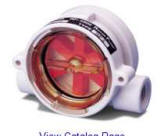 A
sampling of commercially available flow meters at the low end of the price
scale. A
sampling of commercially available flow meters at the low end of the price
scale. |
|
Pressure
Measurements |
| Water Manometer |
A water manometer can be used to
measure pressure differences in inches of water. A manometer can be easily
made from transparent plastic tubing bent into a U shape. The
height of the U should b a bit greater than the maximum pressure
differential you will want to measure. To use
it:
- Fill the U tube up about half way full with water.
- Connect the top of one side of the U to the pressure source to be measure
using a tube. Leave the other end of the U open.
- With the pressure applied, measure the difference in height between the water columns in the two
arms of the U. This is the pressure in inches of water. One
inch of water is 0.036 psi.
Ordinary ink pen ink can be used to dye the water. Adding a little
bit of detergent prevents breaking up of the water column.
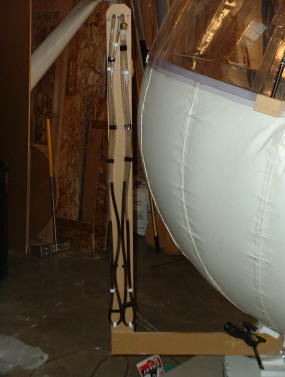 Two
water manometers used to measure the top dome and bottom dome inflation
pressures of an inflatable heliostat. The difference in pressure is
used to focus a flexible aluminized Mylar mirror. You can see that the
pressures are nearly equal, and about 6 inches of water. Two
water manometers used to measure the top dome and bottom dome inflation
pressures of an inflatable heliostat. The difference in pressure is
used to focus a flexible aluminized Mylar mirror. You can see that the
pressures are nearly equal, and about 6 inches of water. Accuracy is excellent,
and cost is near zero. |
| Dwyer Magnehelic
Differential Pressure Gage
www.dwyer-inst.com
|
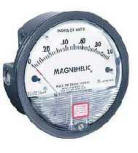 These
Dwyer Magnehelic gages provide an accurate and relatively cheap way to
measure small pressure differences (as commonly occur in solar air systems).
About $50, but often available on ebay for much less. Available with
full scale readings from 0.25 up to more than 100 inches of water.
They are for measuring gas pressures only (not water). These
Dwyer Magnehelic gages provide an accurate and relatively cheap way to
measure small pressure differences (as commonly occur in solar air systems).
About $50, but often available on ebay for much less. Available with
full scale readings from 0.25 up to more than 100 inches of water.
They are for measuring gas pressures only (not water). |
|
Power
Measurements |
| Kill-A-Watt
|
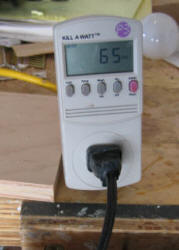 This
amazing gadget measures voltage, current and power (in watts) consumed
by a 120VAC appliance plugged into it. It will also accumulate
energy used (KWH) over the period of time the appliance is plugged into it. This
amazing gadget measures voltage, current and power (in watts) consumed
by a 120VAC appliance plugged into it. It will also accumulate
energy used (KWH) over the period of time the appliance is plugged into it.
The claimed accuracy is 0.2, which is amazing. If you bought the equivalent of this as a "lab instrument", it would
probably cost a thousand dollars.
www.NewEgg.com often
has them for about $20. |
| The Electric
Clock Method |
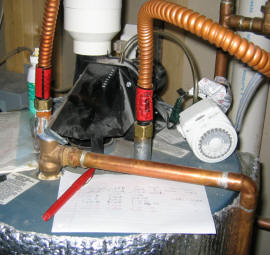 If
you want to know how much power a device is using, and the device has a
fixed and known power consumption when its on, then you can hook up an
electric clock across the connection that goes hot when the device powers
on. The clock will then only run when the device is powered up.
Just set the clock for midnight at the start, and note what time its
pointing to 24 hours later, and you have the daily on time. If
you want to know how much power a device is using, and the device has a
fixed and known power consumption when its on, then you can hook up an
electric clock across the connection that goes hot when the device powers
on. The clock will then only run when the device is powered up.
Just set the clock for midnight at the start, and note what time its
pointing to 24 hours later, and you have the daily on time.
The picture shows using an electric timer to record how many hours
my water heater runs each day by powering the timer from the fan that runs
whenever the burner flue exhaust fan is on (which runs only when the burner
is on). |
| Using your house
electric meter to estimate power used by a load
http://staff.washington.edu/corey/power.html
And, reading your electric and gas meters
www.alpharubicon.com/altenergy/meterreadstryder.htm
|
 The
link describes a way to use the utility company watt-hour meter on your
house to estimate the power consumed by an electrical load of interest.
This is based on each turn of the meter disk representing a fixed number of
watt-hours -- often 3 watt-hours per turn. The
link describes a way to use the utility company watt-hour meter on your
house to estimate the power consumed by an electrical load of interest.
This is based on each turn of the meter disk representing a fixed number of
watt-hours -- often 3 watt-hours per turn.The 2nd link tells you how to
read the totals on your electric and gas meters. |
| Reading your gas meter... |
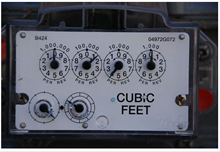 Interesting article on pilot lights gas usage that also shows you how to read a gas meter. Interesting article on pilot lights gas usage that also shows you how to read a gas meter. |
| Power Cost Monitor
http://www.save-electricity.ca/display.html
|
 This
easy to install power meter tells you how much electricity your house is
using (and has used). This
easy to install power meter tells you how much electricity your house is
using (and has used).
The idea being that getting instant feedback when you turn on lights,
appliances, ... will help you cut down on electricity use.
Kind of like driving a Prius and seeing what your current mpg is all the
time. |
|
Solar
Intensity |
| Apogee
Pyranometer
http://www.apogee-inst.com/pyr_spec.htm
|
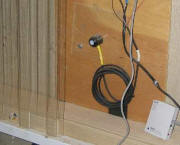 I
finally bit the bullet and got an Apogee Pyranometer in order to be able to
measure sun intensity accurately. The Apogee outputs 2 mv per watt/m^2
of solar radiation (so about 2 volts for full sun). It is factory
calibrated to +- 5%, and is cosine corrected. About $180. It
works well with the Onset logger which will convert the voltage readings
directly to watt/m^2. So far, I have been quite happy with it, and
have a number of projects planed for it. I
finally bit the bullet and got an Apogee Pyranometer in order to be able to
measure sun intensity accurately. The Apogee outputs 2 mv per watt/m^2
of solar radiation (so about 2 volts for full sun). It is factory
calibrated to +- 5%, and is cosine corrected. About $180. It
works well with the Onset logger which will convert the voltage readings
directly to watt/m^2. So far, I have been quite happy with it, and
have a number of projects planed for it.
Shown here set up to determine if the corrugations on SunTuf glazing reduce
its transmission
Details ... |
Measuring
Sunlight at Earth's Surface: Build Your Own Pyranometer,
David Brooks
www.instesre.org/construction/pyranometer/pyranometer.htm
Update: I built one of these
kits and tested it against my Apogee Pyranometer for recording solar
radiation during collector tests.... |
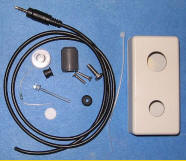 Information
on making and using pyranometers. Information
on making and using pyranometers.
Material on how to order and assemble a $20 pyranometer kit.
The References section at this link contains some in depth papers on
measuring and modeling solar radiation at the earths surface. |
| Measuring Solar
Radiation -- A Cheap Solar Radiation Meter
http://chuck-wright.com/projects/pv-measure.html
|
 How to
understand, build, calibrate and use a Pyranometer based on an inexpensive
PV cell.
Details... How to
understand, build, calibrate and use a Pyranometer based on an inexpensive
PV cell.
Details...From Chuck Wright's website -- other interesting solar projects,
and renewable energy project data logging systems:
http://chuck-wright.com/projects.html |
| Micro Circuit
labs Solar Meter and Logger
http://www.microcircuitlabs.com/index.htm
|
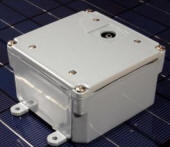 Micro
Circuit Labs offers a solar data logger and a solar meter both in kit or
assembled form. Micro
Circuit Labs offers a solar data logger and a solar meter both in kit or
assembled form.Battery powered logger has a silicon photodiode as the
sensor, and will log up to 16K sun measurements over up to 170 days.
Said to have 5% accuracy. Price -- $70 to $150. |
| Onset Pendant
Light Meter
www.onsetcomp.com
(search their site for "Pendant" if you have
trouble finding them) |
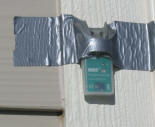 This
compact and self contained logger measures light intensity in lumens/ft^2
and temperature. It will handle full sunlight, and you could
correlate lumens/ft^2 to watts/m^2 to get a rough idea of solar intensity.
It has an internal battery, and requires no connection to computer during
logging. Case is a bit like a small pill bottle, and is water
resistant. Price is about $40, but you also need the coupler and
software, which add many dollars -- so this option might be best if you have
or plan to use other Onset loggers. This
compact and self contained logger measures light intensity in lumens/ft^2
and temperature. It will handle full sunlight, and you could
correlate lumens/ft^2 to watts/m^2 to get a rough idea of solar intensity.
It has an internal battery, and requires no connection to computer during
logging. Case is a bit like a small pill bottle, and is water
resistant. Price is about $40, but you also need the coupler and
software, which add many dollars -- so this option might be best if you have
or plan to use other Onset loggers. |
|
Motor On Time |
| Logging Motor On
Tim www.onsetcomp.com |
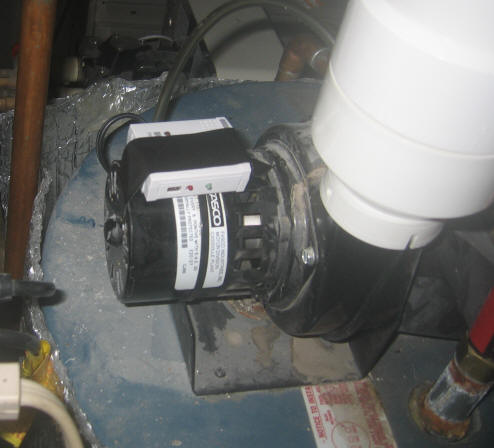 The
small logger in the picture (white box) logs the on time for the motor its
attached to. No wiring connections -- the logger senses the motor
magnetic field. The
small logger in the picture (white box) logs the on time for the motor its
attached to. No wiring connections -- the logger senses the motor
magnetic field.
This Onset motor on/off monitor is the one I use -- I'm sure there are
others. It is very easy to use -- just tape it to the side of the
motor.
Price of this one is $79 + software.
Lots of uses -- some examples ... |
|
Force |
| "Fish" Scale |
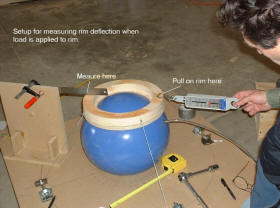 Measuring
deflection vs force for a model heliostat using a "fish" type spring scale. Measuring
deflection vs force for a model heliostat using a "fish" type spring scale.
Inexpensive digital versions of "fish" or "game" scales are now available.
The one I have is reliable and accurate. |
| Gravity and
pulleys
|
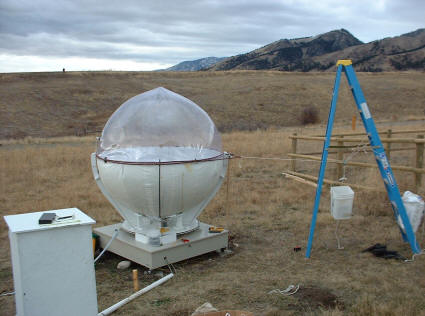
The weighted bucket applies a known force to the edge of the heliostat
via the rope over a pulley.
Not very elegant, but it works!
Used to estimate the heliostat beam displacement for high wind conditions.
I have found the digital bathroom scales to be an accurate way to measure
the weights, but known quantities of water at 8.3 lb per gallon can also be
used. |
Data Loggers
Data loggers allow you to record temperatures, voltages, events, ... at
regular intervals.
The interval can typically range from once a second or less to hours, and
the time period over which data is logged can be minutes to months.
Values recorded by the logger are typically transferred to a computer for
processing or plotting.
Data loggers are typically NOT required for most solar thermal experiments
-- you can get equally good results by just manually reading and recording
sensor values -- the loggers just make life easier. |
| Onset Computer
Data Loggers
www.OnsetComp.com
|
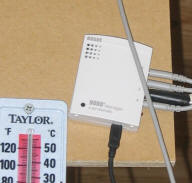 This
standalone 4 channel Onset data logger records data from up to 4 sensors of
various types with no external power or connections for periods up to
months. This
standalone 4 channel Onset data logger records data from up to 4 sensors of
various types with no external power or connections for periods up to
months.
More...I mention this specific brand, because it is the one have used,
and have experience with -- I am sure there are other very capable loggers
out there. |
| Home made
temperature logger from AnotherURL.com
www.anotherurl.com/therm/logger.htm
|
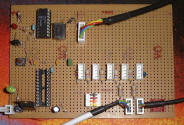 A
home made temperature data logger based on the inexpensive Dallas
Semiconductor DS18B20. This logger supports up to 64 sensors.
The sensors use the Dallas Semi "one wire" bus, which means that the sensors
can be a 100 ft or more from the logger, and require minimal cabling, and no
separate power. The logger interfaces the sensors to a Windows PC.
More than 100 of these logger have been built. A
home made temperature data logger based on the inexpensive Dallas
Semiconductor DS18B20. This logger supports up to 64 sensors.
The sensors use the Dallas Semi "one wire" bus, which means that the sensors
can be a 100 ft or more from the logger, and require minimal cabling, and no
separate power. The logger interfaces the sensors to a Windows PC.
More than 100 of these logger have been built.There are other versions of
loggers that make use of the "One Wire" sensors. Try a google for the
latest. |
| Measuring Energy
Usage for Inverter & Battery Bank Sizing Mark Patton
www.HomePower.com
Search HP archives for issue 76 |
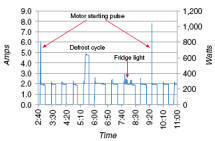 Good
Home Power article on using an Onset Computer logger to measure power
consumption for PV system sizing. Good
Home Power article on using an Onset Computer logger to measure power
consumption for PV system sizing.
This is a year 2000 article, so some of the hardware may be a bit out of
date, but the techniques are still applicable. |
1-Wire HVAC Monitoring
System for a Residential Geothermal System
The system logs many sensors and provides real-time and historic data
over the internet.
|
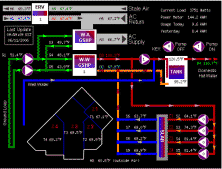 Phil
describes his system for monitoring the status and performance of his
heating system in "Our
Cool House". This system uses the 1-Wire bus (and more) to allow
several types of sensors to be logged. A dedicated micro- processor is
used to reduce the power consumption of the system. The logged values
are sent to a web server, and can be accessed from by web browser. Phil
describes his system for monitoring the status and performance of his
heating system in "Our
Cool House". This system uses the 1-Wire bus (and more) to allow
several types of sensors to be logged. A dedicated micro- processor is
used to reduce the power consumption of the system. The logged values
are sent to a web server, and can be accessed from by web browser.
Phil sells kits for the logger main board, and for some of the sensors.
He also provides the software, including source code (so you can customize
if you wish).
Our Cool
House is Phil and Lisa's very interesting, passive solar, earth
sheltered, geothermal house -- their website provides lots of good
information on the design an building of their house. Its in our "I
Did It" homes section. |
myDTC
controller/logger
www.mydtcstore.com/ |
 The
myDTC is primarily a controller (a very flexible one), but also includes a
logging function that is able to store a number of sensor values over a
longish period of time. The
myDTC is primarily a controller (a very flexible one), but also includes a
logging function that is able to store a number of sensor values over a
longish period of time.
One of the sensors offered is a solar radiation sensor, which can also be
logged. |
Some Sample Measurement Setups
Here are a few sample test setups that I had some pictures for.
This is not rocket science -- one of the nice things about Solar Thermal is
that you can do good work with simple test setups. Here are some
simple examples that might be helpful to folks who have not done much of
this stuff. |
| A Test Solar
Water Collector
|
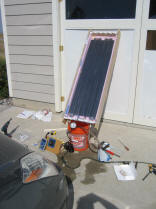 A
simple setup that measures the output of a small collector built to test a
new design. A
simple setup that measures the output of a small collector built to test a
new design.
More ... |
| Some
Additional ones: |
Some Additional ones:
Grey Water Heat Exchanger In A Barrel
Temperature Stratification i Tall Room
Low Tech Garage/Barn Heater
Flow Organizer
Combined Collector and
Thermal Shade
Transmittance of Corrugated Glazing
Simple Pool
Heating Collector |
|
Measuring Collector Performance |
How to measure:
- Collector Heat Output
- Collector Efficiency
Common collector design misconceptions.
|
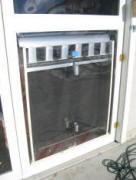 Some
simple techniques to measure collector performance, and determine if design
changes that you make actually improve performance. Some
simple techniques to measure collector performance, and determine if design
changes that you make actually improve performance.
A very rough way to estimate collector efficiency.
A list of common collector design misconceptions.
More... |



 Some
notes on various ways to measure airflow for a solar collector, and how well
they work (or don't).
Some
notes on various ways to measure airflow for a solar collector, and how well
they work (or don't). Ordinary
hardware store alcohol thermometers work fine for measuring temperatures in
most solar thermal systems.
Ordinary
hardware store alcohol thermometers work fine for measuring temperatures in
most solar thermal systems. If you want to move up to a more accurate and precise thermometer, here is one example.
If you want to move up to a more accurate and precise thermometer, here is one example. They require some circuitry and a display to show the temperature, or a
data logger to record the temperature readings. Or, an ohm meter can
be used to find the resistance, and then look up the temperature in a table.
They require some circuitry and a display to show the temperature, or a
data logger to record the temperature readings. Or, an ohm meter can
be used to find the resistance, and then look up the temperature in a table. A thermocouple is a junction of two
different metals. Temperature changes at the junction generate a
voltage that is proportional to the temperature.
A thermocouple is a junction of two
different metals. Temperature changes at the junction generate a
voltage that is proportional to the temperature.

 Thermal
imaging cameras offer an unmatched capability to view the temperatures over
a whole surface.
Thermal
imaging cameras offer an unmatched capability to view the temperatures over
a whole surface. This is an IR (thermal) camera that you can build for a couple hundred(?) dollars.
This is an IR (thermal) camera that you can build for a couple hundred(?) dollars. If you can arrange it so that the
fluid flow to be measured can be diverted to a container of know size you can get very
accurate flow rate measurements by just timing how long it takes to fill the
container. A stopwatch is helpful for accurate
measurements. Make sure that whatever you do to divert the
flow does not itself change the flow rate. If you do this carefully, it will provide better accuracy than
all but the most sophisticated flow meters, and do it for zero cost.
If you can arrange it so that the
fluid flow to be measured can be diverted to a container of know size you can get very
accurate flow rate measurements by just timing how long it takes to fill the
container. A stopwatch is helpful for accurate
measurements. Make sure that whatever you do to divert the
flow does not itself change the flow rate. If you do this carefully, it will provide better accuracy than
all but the most sophisticated flow meters, and do it for zero cost. An
example of using these water meters to measure and log flow rate and total
flow of water (including hot water).
An
example of using these water meters to measure and log flow rate and total
flow of water (including hot water). A
sampling of commercially available flow meters at the low end of the price
scale.
A
sampling of commercially available flow meters at the low end of the price
scale. These
Dwyer Magnehelic gages provide an accurate and relatively cheap way to
measure small pressure differences (as commonly occur in solar air systems).
About $50, but often available on ebay for much less. Available with
full scale readings from 0.25 up to more than 100 inches of water.
They are for measuring gas pressures only (not water).
These
Dwyer Magnehelic gages provide an accurate and relatively cheap way to
measure small pressure differences (as commonly occur in solar air systems).
About $50, but often available on ebay for much less. Available with
full scale readings from 0.25 up to more than 100 inches of water.
They are for measuring gas pressures only (not water). The
link describes a way to use the utility company watt-hour meter on your
house to estimate the power consumed by an electrical load of interest.
This is based on each turn of the meter disk representing a fixed number of
watt-hours -- often 3 watt-hours per turn.
The
link describes a way to use the utility company watt-hour meter on your
house to estimate the power consumed by an electrical load of interest.
This is based on each turn of the meter disk representing a fixed number of
watt-hours -- often 3 watt-hours per turn. Interesting article on pilot lights gas usage that also shows you how to read a gas meter.
Interesting article on pilot lights gas usage that also shows you how to read a gas meter. This
easy to install power meter tells you how much electricity your house is
using (and has used).
This
easy to install power meter tells you how much electricity your house is
using (and has used). I
finally bit the bullet and got an Apogee Pyranometer in order to be able to
measure sun intensity accurately. The Apogee outputs 2 mv per watt/m^2
of solar radiation (so about 2 volts for full sun). It is factory
calibrated to +- 5%, and is cosine corrected. About $180. It
works well with the Onset logger which will convert the voltage readings
directly to watt/m^2. So far, I have been quite happy with it, and
have a number of projects planed for it.
I
finally bit the bullet and got an Apogee Pyranometer in order to be able to
measure sun intensity accurately. The Apogee outputs 2 mv per watt/m^2
of solar radiation (so about 2 volts for full sun). It is factory
calibrated to +- 5%, and is cosine corrected. About $180. It
works well with the Onset logger which will convert the voltage readings
directly to watt/m^2. So far, I have been quite happy with it, and
have a number of projects planed for it. Information
on making and using pyranometers.
Information
on making and using pyranometers.
 How to
understand, build, calibrate and use a Pyranometer based on an inexpensive
PV cell.
How to
understand, build, calibrate and use a Pyranometer based on an inexpensive
PV cell.
 Micro
Circuit Labs offers a solar data logger and a solar meter both in kit or
assembled form.
Micro
Circuit Labs offers a solar data logger and a solar meter both in kit or
assembled form. Measuring
deflection vs force for a model heliostat using a "fish" type spring scale.
Measuring
deflection vs force for a model heliostat using a "fish" type spring scale. A
home made temperature data logger based on the inexpensive Dallas
Semiconductor DS18B20. This logger supports up to 64 sensors.
The sensors use the Dallas Semi "one wire" bus, which means that the sensors
can be a 100 ft or more from the logger, and require minimal cabling, and no
separate power. The logger interfaces the sensors to a Windows PC.
More than 100 of these logger have been built.
A
home made temperature data logger based on the inexpensive Dallas
Semiconductor DS18B20. This logger supports up to 64 sensors.
The sensors use the Dallas Semi "one wire" bus, which means that the sensors
can be a 100 ft or more from the logger, and require minimal cabling, and no
separate power. The logger interfaces the sensors to a Windows PC.
More than 100 of these logger have been built. Good
Home Power article on using an Onset Computer logger to measure power
consumption for PV system sizing.
Good
Home Power article on using an Onset Computer logger to measure power
consumption for PV system sizing. Phil
describes his system for monitoring the status and performance of his
heating system in "
Phil
describes his system for monitoring the status and performance of his
heating system in " The
myDTC is primarily a controller (a very flexible one), but also includes a
logging function that is able to store a number of sensor values over a
longish period of time.
The
myDTC is primarily a controller (a very flexible one), but also includes a
logging function that is able to store a number of sensor values over a
longish period of time. A
simple setup that measures the output of a small collector built to test a
new design.
A
simple setup that measures the output of a small collector built to test a
new design.